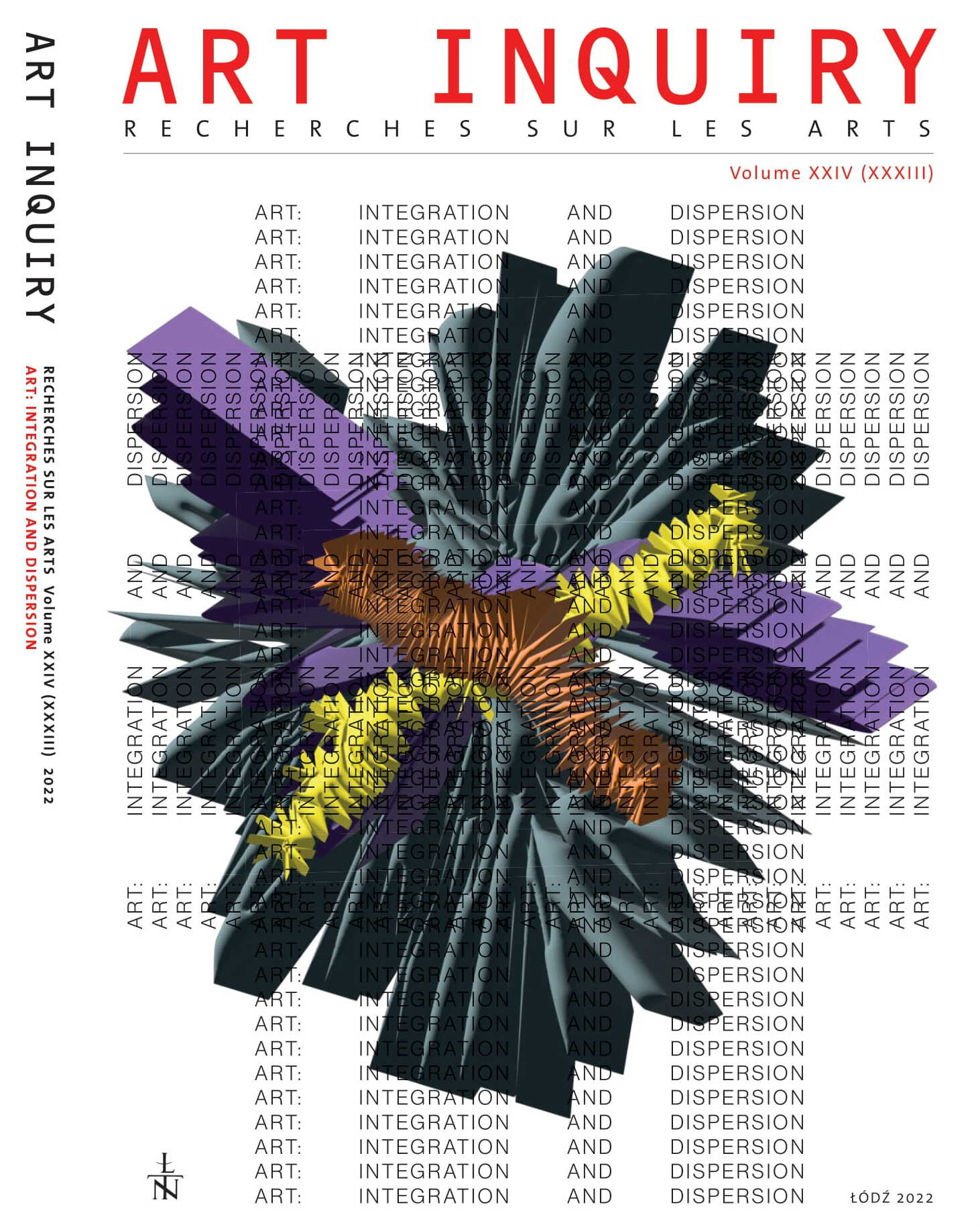Anselm Kiefer: Collecting what is Broken. Works from the Chevirat Ha-Kelim (breaking of the Wessels) Cycle
DOI:
https://doi.org/10.26485/AI/2022/24/7Keywords:
Anselm Kiefer, modern art, Breaking of the Vessels, Isaak Luria, Kabbalah, destruction, repair, collectingAbstract
Anselm Kiefer (a German artist born in 1945) began working on the Chevirat ha-kelim (Breaking of the vessels) cycle in 1990. It is based on the Kabbalistic theory of Isaac Luria (1534-1572) and Nathan of Gaza (1644-1680). Luria, a mystic and founder of the Orthodox Kabbalah, and Nathan of Gaza are the founders of a Kabbalistic myth that corresponds to the historical experiences of the Jewish people.
This myth focuses on three great symbols: cimcum (“shrinking” – i.e., God withdraws himself, through which the world can come into being through emanation), shevira (“breaking of the vessels”) and tikkun olam (“repair”), the Kabbalistic doctrine of the role of man repairing the world.
Since the mid-1980s, when the artist began to use lead, ash, shellac and clay in his works, his thoughts and works have been related to Jewish culture. The Chevirat ha-kelim series of works, which have been shown since 1985 in different places of the world, consists of sculptures, paintings and objects related to the dramatic process of world creation, understood as a cosmic catastrophe.
In Jewish mythology, like in Kiefer's works, shells of clay pots, broken discs, molten lead cards of monumental books and a lead plane with a “crossed” wing are the symbols of destruction. A world marked by a catastrophe requires repair and restoration of original harmony.
Through this symbolism, Kiefer’s works testify, on the one hand, to a melancholic memory that refers to the creation of historical reality (Nazism, Holocaust crimes and their presence in the present). On the other hand, the transmission of his art is linked to the Jewish tradition of faith in the possibility of restoration, of bringing the broken together, and the hope that by working to restore the original order (tikkun olam), redemption, reunification and reconciliation will be achieved. This aspect of Kiefer’s work applies as much to the ethical relationship as to our interaction with myths and religions which presuppose the metaphysics of reality
References
Barron Wells Mary Breaking of the Vessels: Destruction and Creation in the Art of Anselm Kiefer, https://aras.org/sites/default/files/docs/00052Barron.pdf (accessed: 22.06.22).
Bernadac Marie-Laure Athanor, https://www.louvre.fr/sites/default/files/medias/medias_fichiers/ fichiers/pdf/louvredossier-presse-anselm-kiefer.pdf (accessed: 19.4.2020).
Biro Matthieu (1998) Anselm Kiefer and Philosophy of Martn Heidegger, Cambridge.
Bouhours Jean-Michel (2016) Anselm Kiefer, Centre Pompidou, 16 December 2015 – 18 April 2016, Paris.
(ed.)Ehrman Ahrne (2005) Götz Adriani talks to Anselm Kiefer, in: Anselm Kefer für Paul Celan, Galerie Thadeus Ropac, Salzburg.
https://www.flickr.com/photos/artimageslibrary/6217939964/in/photostream/anselm/kiefer/shebirat/ha/Kelim (accessed: 23.06.22).
Jedlińska Eleonora (2006) Szechina albo ucieleśnione Imię Boga. Rzeźba Anselma Kiefera w Hamburger Bahnhoff w Berlinie, “Przegląd Nauk Historycznych” 2006, V, no. 2 (10), pp. 213-224.
Jedlińska Eleonora (2019) Kształty pamięci. Wybrane zagadnienia sztuki współczesnej, Łódź.
Jedlińska Eleonora (2020) Anselm Kiefer at the Louvre Museum and Olafur Eliasson in Versaille: on the narrative space of a work of art, in: “Art Inquiry“ 2020 XXII.
Jonas Hans (1979) Das Prinzip Verantwortung, Frankfurt/Main: Insel.
Jonas Hans (1994) Le Concept de Dieu après Auschwitz: une voie juive, trad. de l’allemand par. Ph. Ivernel, transl. from French Jedlińska Eleonora, Payot&Rivages, Paris 1994.
Jung Carl Gustaw (1970) Civilization in Transition. The collected works of C.G. Jung, edit. and transl. by Adler Gerhard and Richard Francis Carrington Hull (R.F.C. Haull), Princeton Uni¬versity Press, New York.
Kamczycki Artur (2015) Muzeum Liebeskinda w Berlinie. Żydowski kontekst architektury, Poznań.
Kłoczowski Andrzej, Hans Jonas o boskiej wszechmocy i niemocy Boga, https://kultura.onet.pl/fragmrnty-ksiazek/hans-jonas-o-boskiej-wscechmocy-i-niemocy-boga/psh8qo7. (onet.pl) (acces¬sed: 3.3.22).
Kłoczowski Andrzej (2012) Hans Jonas. Idea Boga po Auschwitz, Kraków.
Kulbyté Agné (2020) The Painteras a Prophet turned toward the Past, “Art Inquiry” 2020, XXII, pp. 39 55.
Mencfel Michał (2004) Sztuka i melancholia. O problemie pamięci w twórczości Anselma Kiefera, “Artium Quaestiones” 2004, XV, Poznań.
Ouaknin Marc-Alain (2006) Tajemnice kabały, transl. Pruscy Krystyna and Krzysztof, Warszawa.
(ed.) Rosenthal Mark (1987) Anselm Kiefer, The Art Institute of Chicago and the Philadelphia Museum of Art, Chicago.
Saltzman Lisa (1999) Anselm Kiefer and Art after Auschwitz, Cambridge.
Scholem Gershom (1996) Kabała i jej symbolika, transl. Kania Ireneusz, Kraków.
Scholem Gerschon (2006), Żydzi i Niemcy, Sejny.
Schelom Gerschom (2007), Mistycyzm żydowski i jego główne kierunki, Warszawa.
Scholem Gershon (2010) O mistycznej postaci bóstwa. Z badań nad podstawowymi pojęciami ka-bały, transl. Haas Agnieszka, Warszawa 2010.
Schwartz J. (2012) Go See - Tel Aviv: Anselm Kiefer ‘Shevirat Ha-Kelim (the breaking of the vessels)’ at Tel Aviv Museum of Art through April 30, 2012 in: http://artobserved.com/2012/01/go-see-tel-aviv-anselm-kiefer-shevirat-ha-kelim-the-breaking-of-the-vessels-at-tel-aviv-museum-of-art-through-april-30-2012/ (accessed: 26.06.22).
Strasser Catherine (2000) Chevirat Ha-kelim: Le bris des vases et Anselm Kiefer: Chapelle de la Salpêtrière, Édition du Regard, Paris.
Terrasse Jean-Marc (2007) Frontieres, en nous, hors de nous, nous - Entretien Jean-Marc Terrasse:Anselm Kiefer au Louvre , edit. du Regard, Paris.
Unterman Alan (1994) Encyklopedia tradycji i legend żydowskich, Warszawa.
Wąs Cezary (2007) Ekstatyczna pustka we współczesnej architekturze kultowej, “Quart. Kwar¬talnik Instytutu Historii Sztuki Uniwersytetu Wrocławskiego”, Wrocław.
Zweite Armin (1989), Anselm Kiefer. The Heigh Priestess, published by Harry N. Abrams, Shelter Island.
Zweite Armin (1989), Anselm Kiefer, Zweistromland. Mit einem Essay von Armin Zweite, Köln.



